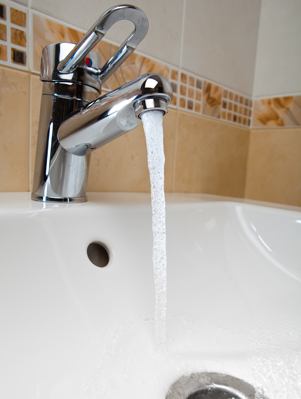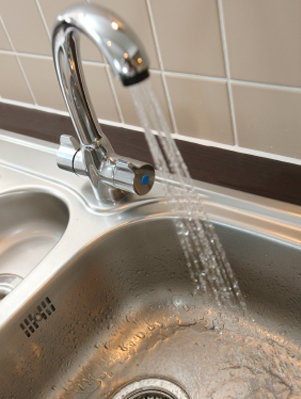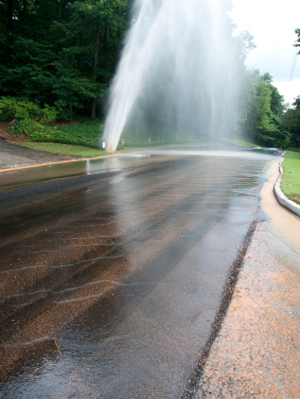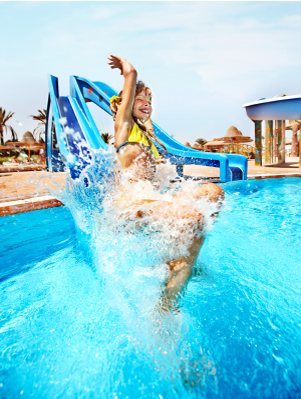Water conservation is a way of life, one that does not require a major change in lifestyle. Mostly, it’s a matter of using common sense. Fresh, clean drinking water is yours to use when needed, but remember that it is a valuable resource that should not be wasted. A little effort will make a big difference. Water can be saved throughout the house by changing both plumbing fixtures and personal habits. You can lower your water bill and help conserve your community’s most precious natural resource. Every drop counts!
![]()
Spring Water Conservation Tips for inside and outside your home:
Check for leaks in pipes, hoses, hose connections, and faucets. Even a tiny leak can translate into thousands of gallons of wasted water over a short period of time. Repair or replace any equipment leaking water immediately.
Use shut-off nozzles on hoses
Use nozzles which completely turn off the water when you are not using it; they also help to more effectively direct water than using your finger to create a stream.
Prioritize Your Springtime Watering Needs Outdoors
Now is a great time for you to prioritize the watering needs of all outdoor plants and trees. Take the time to determine which area of your yard needs the most water.
Keep weeds out of flower and vegetable gardens
Weeds begin to appear around springtime and warmer weather. Weeds are notorious for stealing water away from other plants, so if you’ll keep their populations in check, you won’t have to water as often. With lawns, remove weeds by hand whenever possible to avoid tough competition.
Add mulch to flower beds
Mulch is a great aid in retaining water in garden beds. In most cases, mulch can reduce evaporation and reduce water usage by over 25 percent.
Water during morning or evening hours
The conditions in which you water can play into the effectiveness. By watering plants in the early morning or evening, you can reduce evaporation due to the cooler temperatures.
![]()
 Tips for the Bathroom
Tips for the Bathroom
1. Repair dripping faucets quickly. If your faucet is dripping at a rate of one drop per second, you can expect to waste 2,700 gallons per year. This adds to the cost of water and sewer utilities.
2. Do not let the faucet run while washing hands, face, or shaving. When shaving, fill the bottom of the sink with enough water to rinse the razor rather than letting the water run. An electric razor saves a great deal of water.
3. Turn the water off while brushing your teeth. If everyone in your family leaves the water on while brushing their teeth, as much as 600 gallons can be wasted each month (assuming a household of 4 people, brushing for 1 minute twice a day, with a 2.5 gpm faucet).
4. Do not use the toilet as a wastebasket. Each flush of a standard toilet uses over 3 gallons.
5. Replace or adjust a toilet handle that sticks and lets water run constantly.
6. Use dye strips or food coloring in the toilet tank. If the color shows in the bowl, your flapper is leaking. Most replacement parts are inexpensive, readily available and easily installed. (Flush as soon as your test is done, since food coloring may stain tank.)
7. Replace your toilet flapper as needed, as this component is the most likely to leak. Reminder: If you have a low flow toilet you may need to purchase a special flapper to keep your conservation benefit!
8. Replace your showerhead with an ultra-low-flow version.
9. Take shorter showers.
10. Install water saving flow restrictors.
![]()
 Tips for the Kitchen
Tips for the Kitchen
1. Keep a container of water in the refrigerator rather than letting water run to obtain a cold drink.
2. Designate one glass for your drinking water each day. Or, carry a reusable water bottle. This will cut down on the number of times you run your dishwasher.
3. While most conventional dishwashers use anywhere between 7 to 14 gallons per load (gpl), a water-efficient dishwasher only uses 4.5 to 7 gpl.
4. Washing a partial load of dishes uses the same amount of water as a full load.
5. Soak heavily soiled dishes and pans in soapy sink water instead of scraping under running water.
6. If washing dishes by hand, rinse them in a half-full basin or pan instead of under running water.
7. Before draining your dishwater, use it to rinse out recyclable glass, cans or plastic containers.
8. Turn on the garbage disposal when pulling the plug on dirty dishwater. This allows the disposal to be cleaned out without using more water from the faucet.
9. Dispose of paper and excess food in the garbage rather than the garbage disposal. Garbage disposals can add 50 percent to the volume of solids in wastewater, which can lead to maintenance problems.
10. To clean vegetables, use the sink or a bowl to retain water. Scrub with a vegetable brush and turn on water only for a quick rinse.
11. Thaw frozen foods in advance in the refrigerator or use the microwave instead of running water.
12. Take ice cube trays from the freezer a few minutes before they are needed. The ice cubes will loosen at room temperature without the need to run them under tap water.
![]()
Tips for the Laundry Room
1. Washers purchased before 1999 use 4 times the energy of a newer model and waste 30 gallons of water per load. Is it time for your washer to be replaced? Look for the most water efficient model that fits your needs and your budget. And remember that due to long-term utility bill savings, a more expensive model may pay for itself in 5 years.
2. Fill the washing machine with a full load of laundry. If your machine has a water level selector, make sure it is always set to match the amount of laundry being washed.
![]()
1. Avoid purchasing recreational water toys that require a constant stream of water.
2. If you have a swimming pool, consider a new water-saving pool filter. A single back flushing with a traditional filter uses 180 to 250 gallons of water.
3. In the summertime, an uncovered pool loses about an inch of water per week. Covering your pool when not in use can reduce that by 90%. A pool cover also provides added safety.
4. Do not hose down your driveway or sidewalk. Use a broom to clean leaves and other debris from these areas.
5. Avoid the installation of ornamental water features (such as fountains) unless the water is recycled.
6. Use a shut-off nozzle on your hose, which can be adjusted down to a fine spray so that water flows only as needed. When finished, turn it off at the faucet instead of at the nozzle to avoid leaks.
7. Check hose connectors to make sure plastic or rubber washers are in place. Washers prevent leaks.
8. If you must water lawns, do so at night or in the early morning. The plants absorb the water more efficiently when heat from the sun is at its weakest. More water evaporates during hot daytime hours.
9. Don’t over water your landscaping. Wilting can be a sign of excess water. As a general rule, lawns only need one inch of water per week, less in the winter. Use a rain gauge to determine how much water your yard receives each week from rain and irrigation.
10. Don’t allow sprinklers to water your street, driveway or sidewalk. Position them so water lands on the lawn and shrubs… not the paved areas.
11. Install irrigation devices that are the most water efficient for each use. Soaker hoses and micro or drip irrigation are examples.
12. Check sprinkler systems and timing devices regularly to be sure they operate properly.
13. Do not leave sprinklers or hoses unattended. A garden hose can pour out 600 gallons or more in only a few hours. Use a kitchen timer to remind yourself to turn off sprinklers.
14. Raise the lawn mower blade to at least three inches or to its highest level. A higher cut encourages grass roots to grow deeper, shades the root system and holds soil moisture better than a closely clipped lawn.
15. Regularly aerate your lawn and remove thatch to allow water to penetrate the soil surface.
16. Avoid over fertilizing your lawn. Fertilizer applications increase the need for water. Apply fertilizers that contain slow-release, water-insoluble forms of nitrogen.
17. Group plants together based on similar water needs. This will reduce over-watering of the plants that don’t need as much.
18. Plant native and/or drought-tolerant grasses, ground covers, shrubs and trees. Once established, these plants will require less water, fertilizer and maintenance than a typical lawn. They’re more likely to survive a dry period too.
19. Use mulch to retain moisture in the soil. Mulch also helps control weeds that compete with landscape plants for water.
20. Use a bucket to wash your car instead of a hose, or consider using a commercial car wash that recycles water.
![]()
 General Tips
General Tips
1. Pay attention to your water bill. Does your usage spike during certain times of the year, like the summer? If so, consider implementing more of the Outdoor Tips. Is your overall usage increasing over time? That could indicate a leak.
2. Make sure you know where your water shut-off valve (PCO) is located. This could save gallons of water and damage to your home if a pipe were to burst.
3. Report all significant water losses (broken pipes, open hydrants, etc.) to the property owner or your water company.
4. Install water-softening systems only when necessary. Save water and salt by running the minimum amount of regenerations necessary to maintain water softness. Turn softeners off while on vacation.
5. Don’t waste water just because someone else is footing the bill, such as when you are staying at a hotel. Every community benefits from conservation efforts.
6. Never pour water down the drain when there may be another use for it.
![]()
Tips for Community Change
1. Encourage your friends and neighbors to be part of a water-conscious community. Promote water conservation in community newsletters, on bulletin boards and by example.
2. Encourage your employer to promote water conservation in the workplace. Suggest that water conservation be put in employee orientation and training programs.
3. Patronize businesses that practice and promote water conservation, such as restaurants that only serve water upon request.
4. If you own a business, incorporate the water conservation suggestions.
5. Be aware of and follow all water conservation and water shortage rules in effect in your community.
6. Encourage your school system and local government to help develop and promote a water conservation ethic among children and adults.
7. Support projects that will lead to an increased use of reclaimed wastewater for irrigation and other uses.
8. Support efforts and programs that create a concern for water conservation among tourists and visitors to our state. Make sure your visitors understand the need for, and benefits of, water conservation.
9. Get involved in water management issues. Voice your questions and concerns at public meetings conducted by your local government or water management district.
 The Last Tip
The Last Tip
Try to do one thing each day that will result in saving water. Don’t worry if the savings are minimal. Every drop counts. You can make a difference.

